Why the New Forest is so important for reptiles
PUBLISHED ON: 8 MAY 2025By Eryn McDonald and Ashley Bartlett
Nestled in the heart of southern England, the New Forest National Park stands as a captivating landscape of ancient woodlands, heathlands, and grasslands.
The New Forest National Park is a unique area that is one of the few places in the UK that has all six reptile species: adder, sand lizard, slow worm, grass snake, common lizard, and smooth snake.
The National Park’s diverse landscapes provide ideal conditions for reptiles that depend on warm, dry areas to bask and regulate their body temperature. The heathlands, in particular, are a stronghold for species like the sand lizard and smooth snake, both of which are among the UK’s rarest reptiles.
Reptile species
Adder

The UK’s only venomous snake, the adder is easily recognized by the dark striking zigzag pattern along its back and stockier appearance. Adders thrive in the New Forest’s heathlands, open woodlands, and rough grasslands. On sunny days, you might spot one along a path, making the National Park a prime location for observing this elusive predator.
Sand lizard
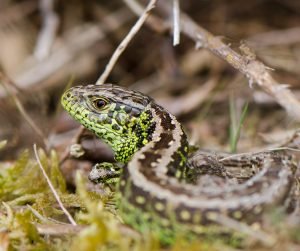
This European protected species can be easily identified by the prominent ‘eye spots’, darker brown markings with light centres, set against a brown or grey background with distinct light grey-brown dorso-lateral (on its back and side) stripes. The male has striking green flanks which are particularly bright during the breeding season in late April and May. The sand lizard has historically faced massive population declines and the New Forest’s sandy heathlands have been key to their recovery, offering perfect breeding and basking grounds.
Slow worm
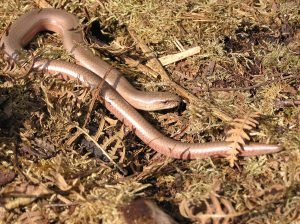
Credit: Rob Free
Often mistaken for a snake, slow-worms are uniform grey-brown legless lizards that uses a range of habitats. In the New Forest, they can most commonly be found in woodland, heathland and grassland with scrub, favouring sheltered areas such as grass and compost heaps, rarely basking in the open.
Grass snake
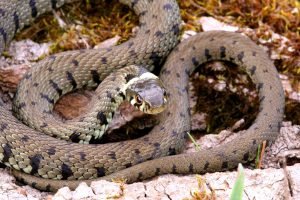
The UK’s largest snake, identifiable by its grey-green body and pale collar, can be found in the forest’s wetlands and grasslands. The forest provides ample hunting grounds for this non-venomous species, which preys on amphibians and small mammals.
Common lizard
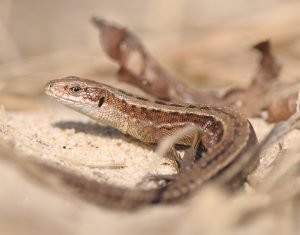
Widespread across the National Park, this small, agile lizard inhabits open heath, grasslands, and open woodlands. These lizards are our most seen reptile but will quickly dart into cover when disturbed.
Smooth snake
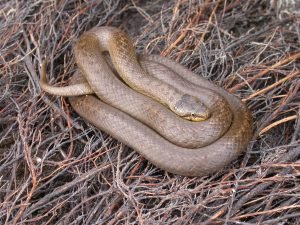
The rarest and most secretive of the UK’s reptiles, the smooth snake is a small, slim grey/brownish snake with a black heart shaped mark on the top of the head and is a New Forest specialty. This European protected species is restricted to the heathland areas of the Forest, preferring areas of deep mature heather on south-facing slopes.
Unique habitats of the Forest under threat
The New Forest’s sandy heathlands are a rare and precious ecosystem in the UK and these areas contain some of the last remaining populations of our rarest reptiles. The mature heather and vegetation provide an ideal habitat for the smooth snake and the undisturbed sandy ridges are a vital breeding ground for the sand lizard. Reptiles such as these, along with the adder are characteristic heathland species and require this specialised habitat to survive.
Despite its protected status, the New Forest and its reptile inhabitants face threats from urbanisation, recreation, and climate change. Over the last 2,050 years, lowland heathland has quickly disappeared from our landscape. Lost to forestry, farming, infrastructure and material extraction, lowland heath has become fragmented and isolated, increasing the pressures on reptile species, reducing their distribution and population size.
Protecting these reptiles and their habitats requires active effort. By safeguarding this unique ecosystem, we not only preserve its natural beauty but also play a vital role in the conservation of some of the UK’s most vulnerable wildlife.
Species Survival Fund project
Led by the New Forest National Park Authority, the £1.3 million New Forest Species Survival Fund project involves working with five partners to help halt the decline of reptiles and other species through creating and restoring habitats in the Forest. The Fund was developed by Defra and its Arm’s-Length Bodies and is being delivered by The National Lottery Heritage Fund in partnership with Natural England and the Environment Agency.
Over half of the New Forest’s unique landscape is internationally important for wildlife – a higher proportion than in any other English National Park. This project seeks to protect this iconic landscape for future generations at a ‘landscape scale’ – not only within the boundaries of the National Park but into surrounding areas.
One focus for Amphibian and Reptile Conservation within the project is restoring heathland habitats to promote the distribution of the local reptile populations, in particular, the sand lizard, smooth snake, and adder. This work not only improves species recovery but also creates ‘stepping stones’ of critical habitat for reptiles, working to link the New Forest to the Dorset and Surrey Heaths.

